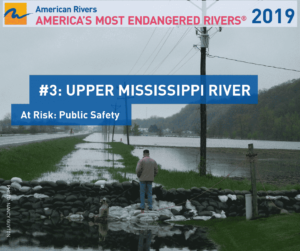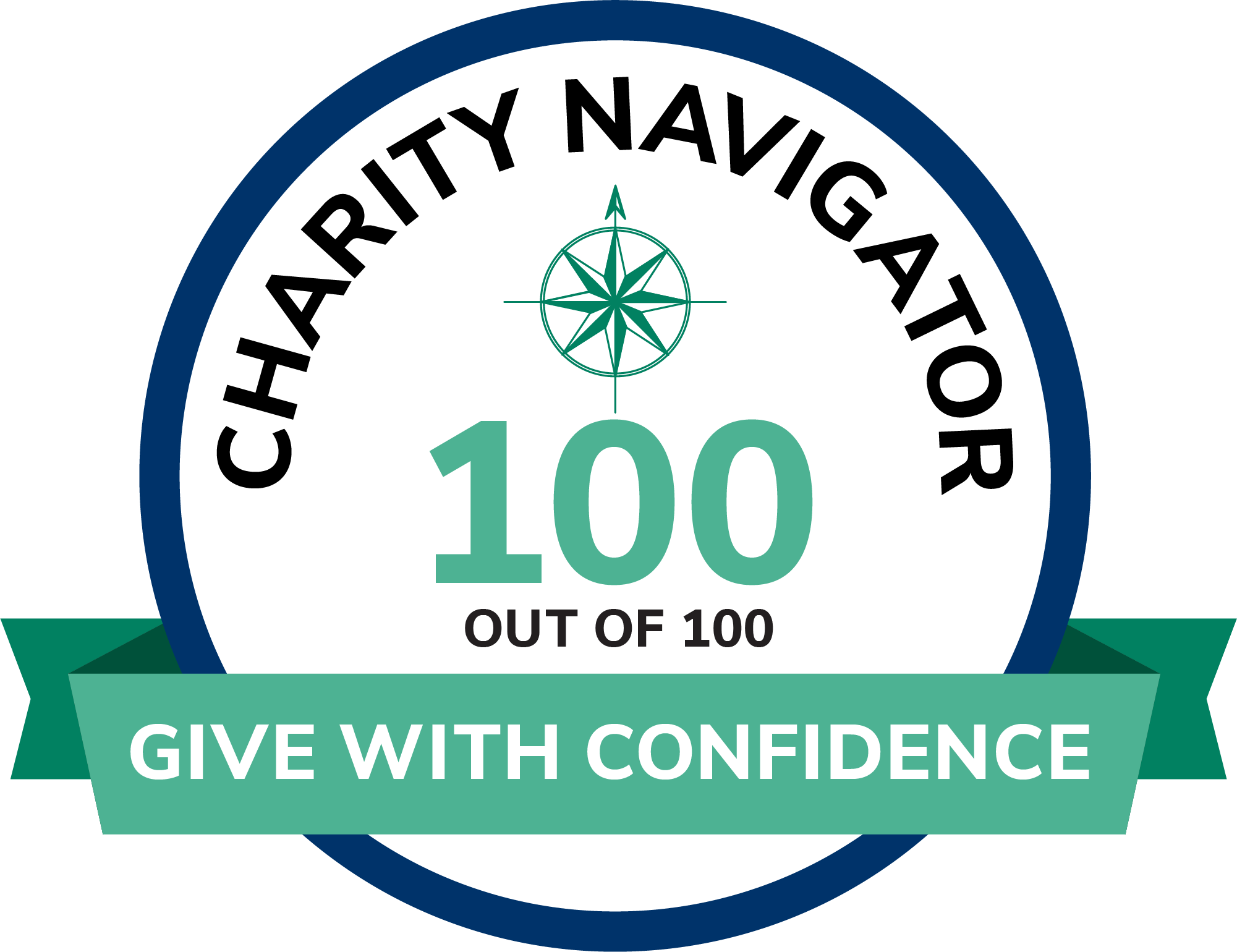Contact: Eileen Shader, American Rivers, (570) 856-1128; Elliot Brinkman, Prairie Rivers Network, (217) 344-2371, x202
UPPER MISSISSIPPI RIVER NAMED ONE OF
AMERICA’S MOST ENDANGERED RIVERS OF 2019
Climate change and illegal levee development threaten public safety, river health
FOR IMMEDIATE RELEASE
Washington, D.C. – American Rivers today named the Upper Mississippi River among America’s Most Endangered Rivers® of 2019, citing the grave threat that climate change and illegal levee raises pose to public safety and river health. American Rivers and its partners called on state and federal agencies to prohibit the reckless raising of levees and promote better flood protection solutions.
“The America’s Most Endangered Rivers report is a call to action to save rivers that face a critical decision in the coming year,” said Eileen Shader with American Rivers. “It’s time to stop the illegal levee development on the Upper Mississippi that is putting people and river health at serious risk.”

“We are already feeling the impacts of climate change in the Midwest, including more frequent and severe flooding, and it’s only going to get worse. Abusing and degrading the Mississippi River will make us more vulnerable to these threats. Protecting and restoring the river will make us better prepared to face future floods and safeguard communities. It’s our choice to make.”
The Upper Mississippi River is threatened by levees that are being raised (i.e., made taller) without required permits and approvals. Eighty miles of levees between Muscatine, Iowa, and Hamburg, Illinois, have been raised without obtaining the required state or federal approvals. These levees not only destroy critical riverside and floodplain habitat for fish and wildlife, they also make flood heights higher and increase flooding downstream. For example, during the most extreme flood events, Hannibal, Missouri, is projected to experience an additional foot or more of floodwaters because their neighbors have raised their levees without regard to the impacts.
American Rivers and its partners called on the U.S. Army Corps of Engineers, the Federal Emergency Management Agency, and the states of Illinois, Iowa and Missouri to take corrective action to stop and resolve these levee violations. Further, the groups called on the agencies to advance 21st century flood protection solutions that deliver multiple benefits to people and nature.
“We have to stop the circle of absurdity where we spend enormous sums of money to build larger levees which make the next flood even worse and costs us millions more in emergency funds, only to have the entire cycle repeat year after year,” said David Stokes with the Great River Habitat Alliance.
“We must move beyond this outdated vision of flood control that foolishly relies on bigger and higher levees and floodwalls to a new vision that makes room for rivers and allows nature-based solutions to protect us,” said Elliot Brinkman with the Prairie Rivers Network.
The threats posed by these unlawful changes are real and getting worse as climate change is leading to more frequent floods and intense storms in the Upper Mississippi River Basin and across the country. The three highest-volume rain storms ever recorded in the U.S. have occurred in the last three years, in line with climate scientists’ projections that extreme downpours in the U.S. could increase by 400 percent by the end of this century. Munoz et al. (2018) determined that the magnitude of 100-year flood events in the Mississippi Basin has increased by 20 percent over the past 500 years, with much of that increase being caused by the combination of river engineering and climate change. The increased risk of flooding is the reason some levee districts have pursued higher levees, but their actions are intensifying the impacts of flooding for their neighbors.
The Mississippi River is a globally significant flyway used by hundreds of species of birds and provides unique habitat for fish, mussels, reptiles and mammals. This significant ecosystem supports commercial and recreational fishing, hunting and boating, which contribute $24.6 billion to the region’s economy and an estimated 421,000 jobs. The river has been the lifeblood of many cultures throughout history and has served as the inspiration for a rich heritage of American music, art and literature.
The annual America’s Most Endangered Rivers® report is a list of rivers at a crossroads, where key decisions in the coming months will determine the rivers’ fates. Over the years, the report has helped spur many successes including the removal of outdated dams, the protection of rivers with Wild and Scenic designations, and the prevention of harmful development and pollution.
Some portion of the Mississippi River was previously included on this list in 1991-1992, 1994-1996, 2000-2001, 2004, 2011, 2014 and 2018. Other rivers in the region listed as most endangered in recent years include the Buffalo National River (2019, 2017) and Middle Fork Vermilion River (2018).
America’s Most Endangered Rivers® of 2019
#1 Gila River, New Mexico
Gov. Grisham must choose a healthier, more cost-effective way to provide water to agriculture than by drying up the state’s last major free-flowing river.
#2 Hudson River, New York
The U.S. Army Corps of Engineers must consider effective, nature-based alternatives to storm-surge barriers that would choke off this biologically rich tidal estuary.
#3 Upper Mississippi River, Illinois, Iowa, Missouri
State and federal agencies must enforce laws that prohibit illegal levees, which increase flood risk for communities and degrade vital fish and wildlife habitat.
#4 Green-Duwamish River, Washington
Local leaders must produce a flood protection plan that safeguards communities and restores habitat for chinook salmon — fish that are essential to the diet of Puget Sound’s endangered orca whales.
#5 Willamette River, Oregon
The U.S. Army Corps of Engineers must immediately improve 13 dams to save wild chinook salmon and steelhead from going extinct.
#6 Chilkat River, Alaska
The Japanese investment firm, DOWA, must do the responsible thing and back out of a mining project that could decimate native salmon.
#7 South Fork Salmon River, Idaho
The U.S. Forest Service must safeguard endangered fish by denying a mining proposal that could pollute this tributary of the Wild and Scenic Salmon River.
#8 Buffalo National River, Arkansas
Gov. Hutchinson must demand closure of an industrial hog-farming facility that pollutes groundwater and threatens endangered species.
#9 Big Darby Creek, Ohio
Local leaders must use state-of-the-art science to craft a responsible development plan that protects this pristine stream.
#10 Stikine River, Alaska
The International Joint Commission of the United States and Canada must protect the river’s clean water, fish and wildlife, and indigenous communities by stopping harmful, polluting mines.
2019’s “River of the Year”: Cuyahoga River, Ohio
American Rivers celebrates the progress Cleveland has made in cleaning up the Cuyahoga River, fifty years since the river’s famous fire that sparked the nation’s environmental movement.
ABOUT AMERICAN RIVERS
American Rivers believes every community in our country should have clean water and a healthy river. Since 1973, we have been protecting wild rivers, restoring damaged rivers and conserving clean water for people and nature. With headquarters in Washington, D.C., and offices across the country, we are the most effective river conservation organization in the United States, delivering solutions that will last for generations to come. Connect with us at AmericanRivers.org.
ABOUT PRAIRIE RIVERS NETWORK
At Prairie Rivers Network (PRN), we protect water, heal land, and inspire change. Using the creative power of science, law, and collective action, we protect and restore our rivers, return healthy soils and diverse wildlife to our lands, and transform how we care for the earth and for each other. PRN is the Illinois affiliate of the National Wildlife Federation.







